Symphyotrichum novae-angliae
New England aster, Symphyotrichum novae-angliae, is a perennial member of the Asteraceae family that includes chrysanthemums and daisies.
Also known as Michaelmas daisy, this nectar-rich flower is native to the US, where it grows wild along roadways and in meadows.
A close look at its vivid violet blue, pink, purple, or white blossoms reveals yellow centers teeming with butterflies and bees, nature’s most beneficial pollinators.
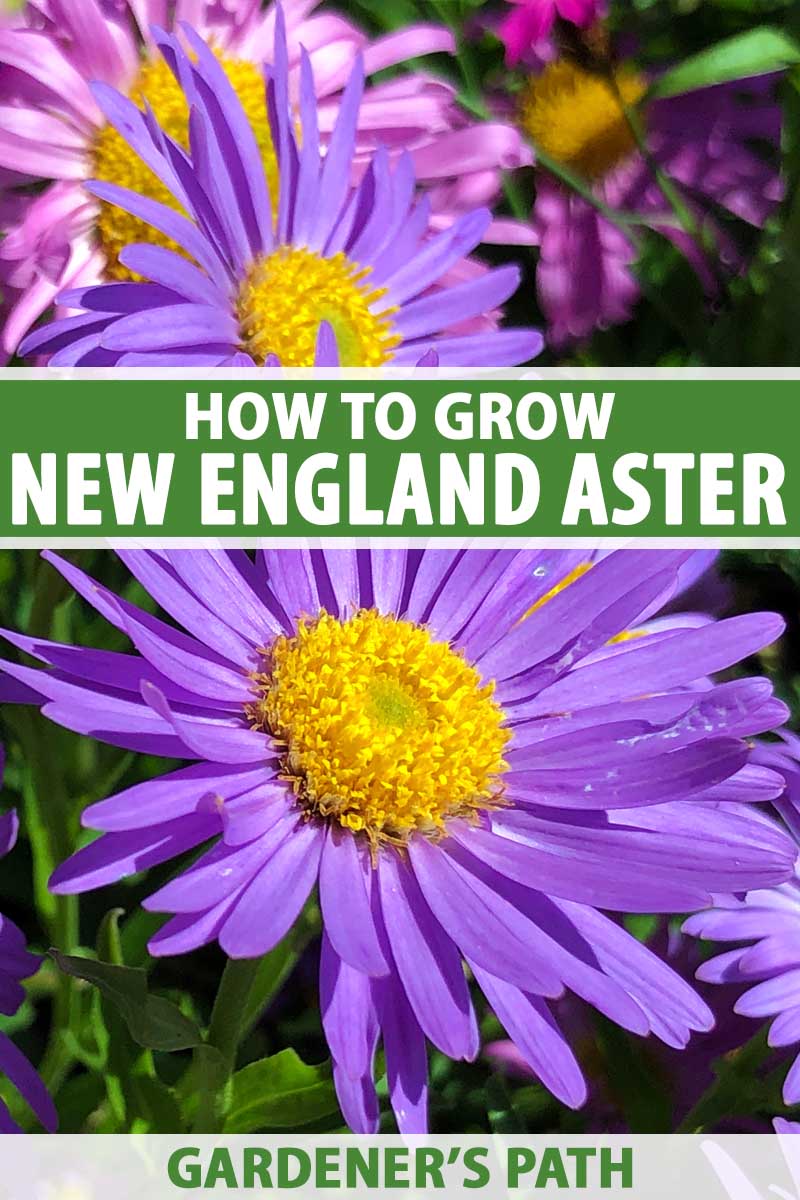
We link to vendors to help you find relevant products. If you buy from one of our links, we may earn a commission.
In this article, you’ll learn how to cultivate and maintain this flowering plant in your garden.
What You’ll Learn
Cultivation and History
The leaves, flowers, and roots of S. novae-angliae have long been used in herbal medicine and purification rituals.
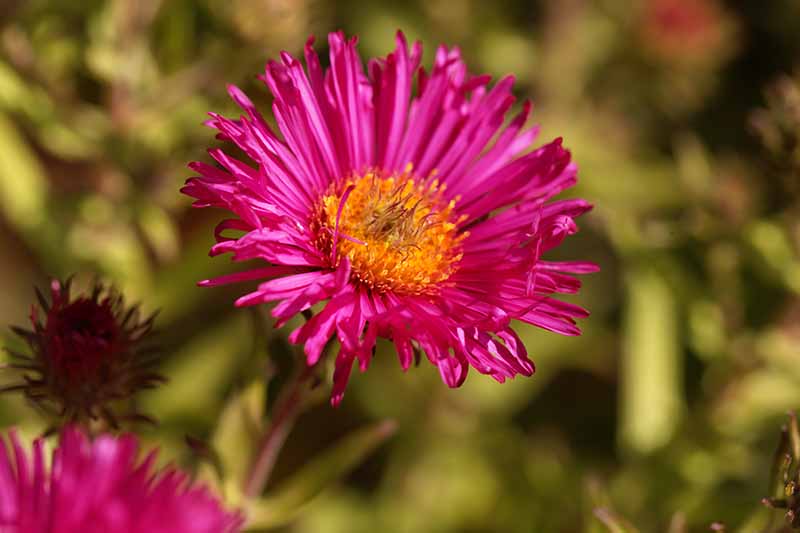
The common name “Michaelmas daisy” refers to September 29, the feast of St. Michael, which happens to fall when the flowers are in full bloom.
In the early 1700s, travelers from England and parts of continental Europe brought the US-native plant home with them, and breeders developed new cultivars. It wasn’t long before the new versions of the plant made their way back to gardens in the United States.
Botanical species plants can reach a towering six feet tall. Modern cultivars offer a more compact choice, topping out at around three feet.
This is a robust plant with an upright growth habit.
The stems grow straight up without branching, and bear conical clusters of daisy-like blooms, with rays of violet blue, pink, or purple surrounding a yellow center disc.
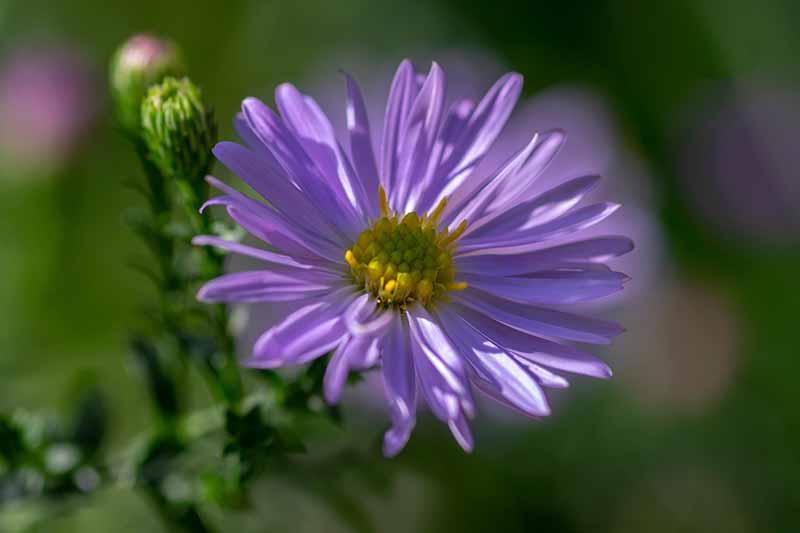
The foliage springs directly from the erect stems in stair-step style. The lance-shaped leaves have smooth margins.
The stems, leaf margins, and leaf undersides are covered in fine hair, a noteworthy characteristic that aids in positively identifying the species.
Formerly a member of the large Aster genus, this flower was reclassified as a Symphyotrichum because of its distinguishing hairy foliage.
New England Aster Plant Propagation
Now that we have a little background, let’s talk about ways to propagate both botanical species and cultivated varieties, so you can get started on your own colorful display.

There are three ways to propagate this plant:
- From Seed
- From Stem Cuttings
- By Division
Let’s take a look at each of them.
From Seed
S. novae-angliae naturalizes in a clumping fashion through vigorous self-seeding, and via a shallow but extensive root system.
The seeds of true botanical species will produce clones of the parent plant.
Seeds from cultivated varieties may produce true to seed, but seeds of hybrids do not yield the same quality or traits of a parent plant.
If you decide to propagate with seeds, here’s how:
Start seeds indoors about a month before the last frost date for your region. Sprinkle one or two seeds in each seed starter pot or egg carton cell filled with potting medium.
Barely cover them, so that they are no deeper than 1/8 inch. Place the containers in a location that receives indirect sunlight. Keep them evenly moist, but not soggy.
Thin the seedlings out when they have one set of true leaves, keeping the stronger of the two in each cell.
When the last average frost date has passed, acclimate the seedlings to the outdoors by setting them out in the sun for two hours or so each day for three or four days.
After acclimation, transplant the seedlings outdoors.
Alternatively, you can direct sow in the garden after the last frost date, all the way up to fall, when asters drop their seeds.
To replicate the characteristics of cultivars and hybrids, use one of the following two techniques.
From Stem Cuttings
In the spring or early summer, you may take a cutting from a soft stem. Here’s how:
Use clean pruning shears to cut a six-inch stem from your plant, removing the leaves from the bottom 3-4 inches. Dip the stem into water and then into a rooting hormone powder.
Fill a seed starting container with potting medium, and plant the cutting 2-3 inches deep.
Keep the container out of direct sunlight, and maintain even moisture but don’t oversaturate it.
Some folks like to make a self-watering mini greenhouse by placing a plastic bag over the stem and container. If you choose to do this, be extra careful not to place it in direct sunlight, or it will cook.
New growth is evidence of root formation and will indicate that the cutting is ready to plant out.
By Division
You can also make new plants from old ones by dividing them. This is a process of cutting straight down through the fleshy roots, removing the divided portion, and planting it elsewhere.
Please see our guide to dividing asters for complete instructions.
How to Grow New England Aster Flowers
Choose a location that gets full sun to part shade and has room for this vigorous perennial to spread.
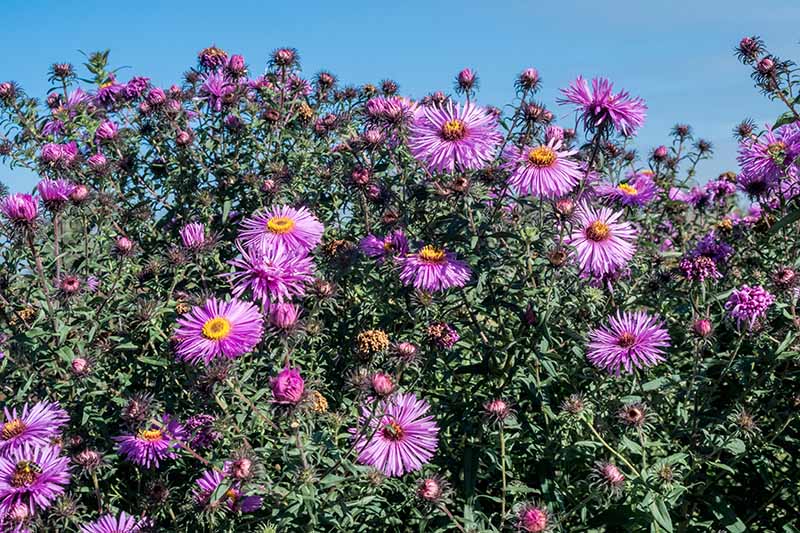
S. novae-angliae does best in organically rich, well-draining soil, like its natural habitat in the wild, but also tolerates clay very well. The pH should be acidic, in the 5.1 to 6.8 range.
Conduct a soil test to better understand the composition of your soil. Otherwise, consider mixing in a shovelful of compost to increase acidity, and compost or sand to improve drainage.
Work the soil (and any amendments) down to a depth of 10 to 12 inches, until it is friable, or crumbly.
Set your seed starter pots or transplants directly into the ground at intervals of one to three feet. Plant transplants at the same depth as the container they were growing in.
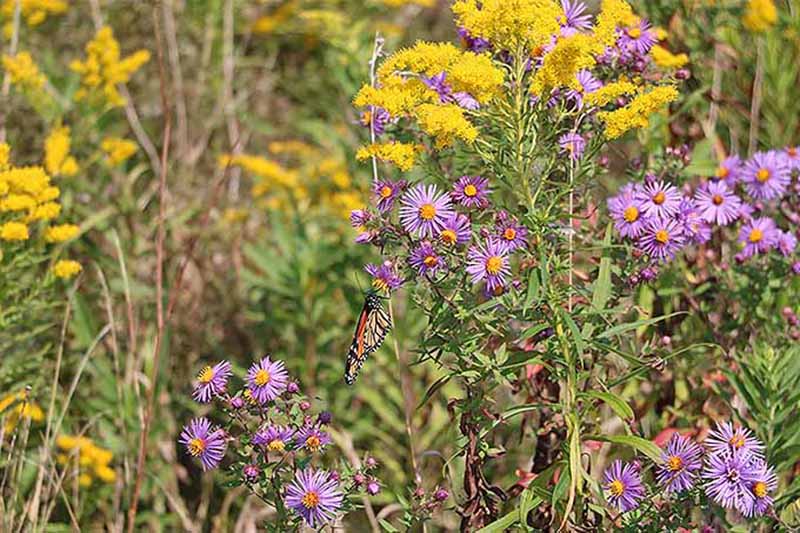
If you’re direct sowing seeds, sprinkle a few over the worked ground at 12-inch intervals. Press them gently to anchor them, and barely cover them with soil, so they are not more than 1/8 inch deep.
Alternatively, if you are growing them in pots, sow seeds in a potting medium in a container that is at least 18 inches wide and 12 inches deep.
You can fertilize with a well-balanced, slow-release granular fertilizer at the time of planting.
Maintain even moisture until plants are established and growing well. At this point, water only if it does not rain at least one inch per week.
When the seedlings have one or two sets of true leaves, thin them to a distance of one to three feet.
Growing Tips
Native asters are easy to grow, and once you give them a good start, they’re well on their way.
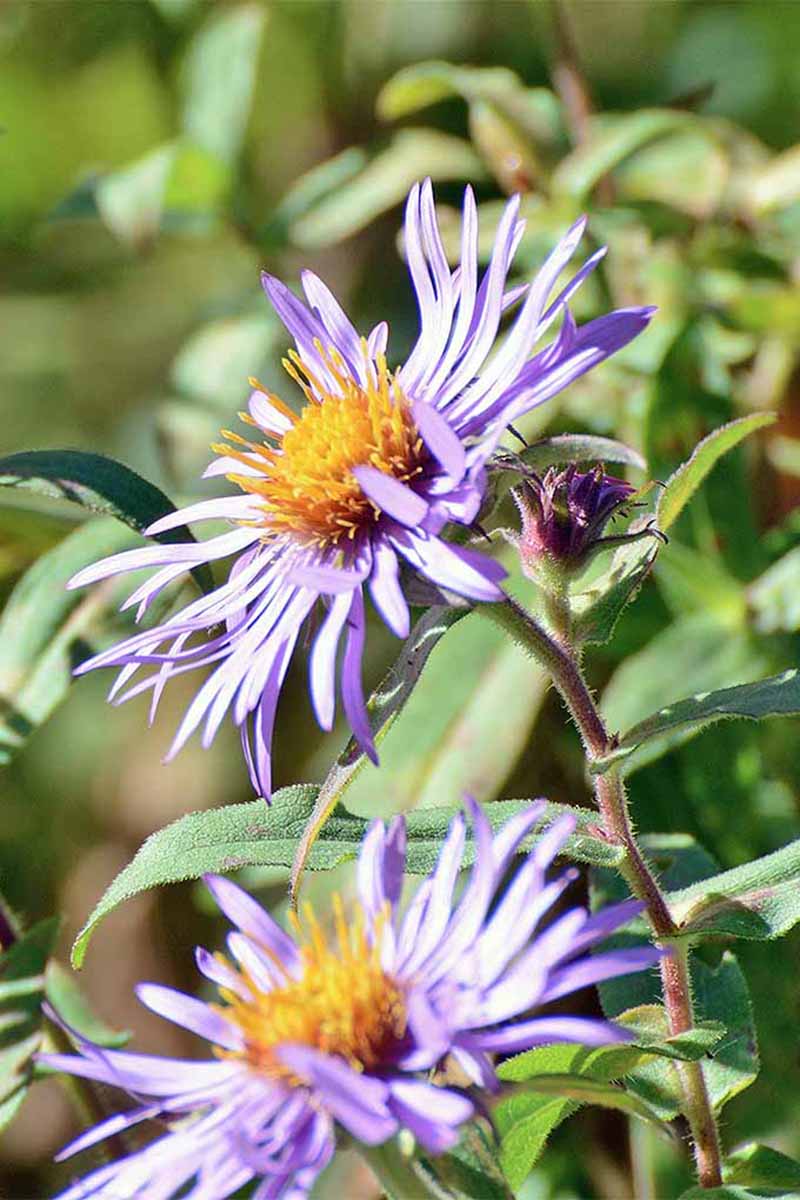
Here are the key points to remember:
- Be generous with the space you allow for plants so they can naturalize by spreading roots and self-sowing.
- Enrich the soil as needed to achieve the acidity appropriate for optimal nutrient uptake.
- Ensure adequate drainage by adding compost or sand to inhibit fungal growth and rotting of roots.
- Barely cover the seeds, as though they were self-sown by the plant itself.
- Maintain even moisture throughout the first growing season, but don’t oversaturate.
- If your plants refuse to flower, check out our guide, “7 Reasons Why Asters Fail to Bloom” for assistance.
Read more about growing perennial aster flowers in this guide.
Pruning and Maintenance
You can fertilize established plants each spring with the same well-balanced, slow-release granular fertilizer you used at planting time.

Spring is also the time to divide plants that are getting wider than you would like.
In addition, you can thin plants to maintain airflow and inhibit fungal growth. Do this by randomly cutting a few stems in each clump all the way to the ground and removing them.
To encourage bushier plants, you can cut off the growing tips of the stems anytime between late spring and early summer, to promote compact growth.
For plants that grow tall, staking may be necessary.
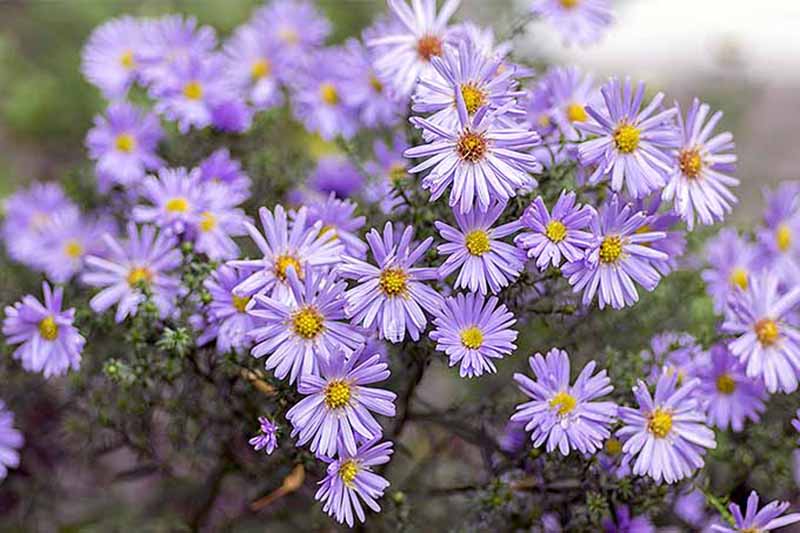
Throughout the growing season, remember to water if it doesn’t rain at least an inch per week.
Check plants periodically for signs of pests and disease. Hand pick, water spray, treat, or remove damaged plant material as needed, per the instructions found in the section below on pests and disease.
Weed regularly to limit competition for water and to maintain good airflow between plants.
To limit self-sowing, cut the flower stems before they go to seed in the fall, and use them in vase arrangements or bouquets to enjoy yourself, and share with others.
If you want to gather seeds from your plants to sow as you choose or to share with friends, please see our guide to collecting native aster seeds.
After your plants are finished for the season, and the first frost comes, either leave the stalks in place for wildlife habitat and attractive winter interest, or prune them down to the ground.
New England Aster Cultivars to Select
Both botanical species and cultivated varieties of New England aster are available.
Native S. novae-angliae tops out at a showy 3 to 5 feet, like its wildflower counterparts in meadows and marshlands.
S. novae-angliae from Nature Hills Nursery
Blossom rays vary from violet blue to pink and purple with yellow centers.
You can find plants in 3-inch containers available from Nature Hills Nursery.
S. novae-angliae ‘Purple Dome’ provides an abundance of bright purple, yellow-centered blossoms from late summer until frost.
‘Purple Dome’ New England Asters
This is a compact plant with two- to three-foot stems that offers a smaller-scale option for more manicured beds or containers.
You can find plants in #1 containers available from Nature Hills Nursery.
Another cultivar you may like is ‘Andenken an Alma Pötschke,’ with its rose pink flowers and manageable height of two to four feet.
Want more options? Find more aster species and cultivars here.
Managing Pests and Disease
As a native species, S. novae-angliae is well-adapted to its environment and has few pest and disease issues.
Starting with quality plants and providing excellent care goes a long way towards keeping them healthy.
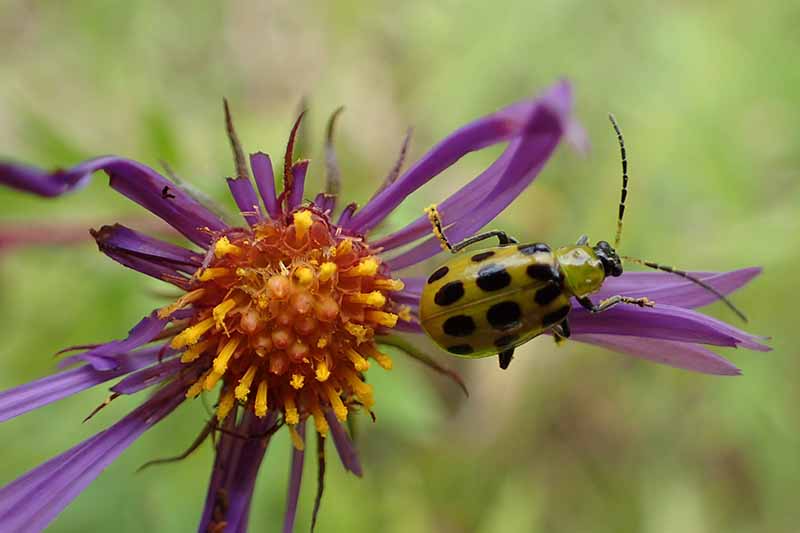
However, sometimes issues arise.
Pests that may visit your flowers include:
- Chrysanthemum lace bugs
- Cucumber beetles
- Leaf miners
- Spider mites
These pests are known for sucking sap from the undersides of the leaves, removing chlorophyll, and causing leaf discoloration and browning.
And while they don’t generally cause enough harm to kill a plant, the damage can be unsightly.
Treatments include hand picking the insects, spraying them firmly with a hose nozzle, or applying an insecticidal soap.
In addition, an application of diatomaceous earth to the ground around the plants may inhibit infestation in the current year and the next.
The spider mite, whether red or two-spotted, causes leaf damage similar to that of the lace bug. It feeds on the undersides of leaves, but doesn’t leave an ugly black trail. A strong hose spray or insecticidal soap should remedy the situation.
As for disease, keep an eye out for the following:
- Aster fusarium wilt
- Powdery mildew
- Rust
All three of these common fungal diseases colonize foliage and flowers, causing discoloration and loss of vigor.
They can be treated by the removal of affected plant material and an application of fungicide.
Give your plants all the help you can. Keep their areas weed-free to minimize insect infestation, the spread of disease, and competition for water.
In addition, adhere to the spacing recommendations of one to three feet, to minimize humidity buildup between plants that can invite fungal growth.
Best Uses for New England Aster Flowers
Once established, S. novae-angliae will reward with years of vigorous growth and exceptional color, making every summer to fall transition a feast for the eyes.
This striking flower pairs well with black-eyed Susan, coneflower, gaillardia, goldenrod, Montauk daisy, ornamental grasses, other types of asters, and garden phlox.
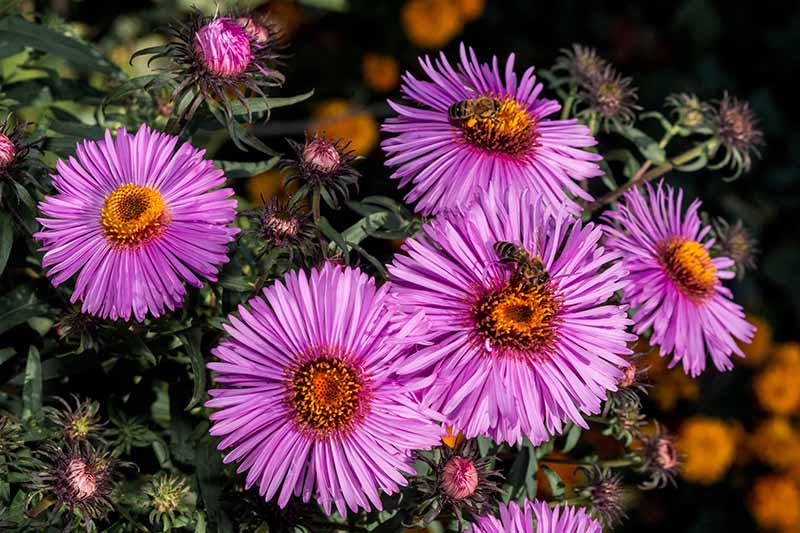
Plant en masse in a meadow where thousands of small blossoms can create a bold splash of color.
Sow seeds along a fence or property perimeter, where plants can form a hedgerow for wildlife.
Use it to provide a texturally rich, green anchor for the back of a summer flower bed. When the hot-weather blooms fade, showy asters take center stage.
And finally, select smaller-stature cultivars for container plantings on patios and at front entries, for a pop of color as summer yields to fall.
I like native asters because they attract a host of beneficial insects, butterflies, and birds to my gardens, where I can observe them up close.
And if you’re looking for a cutting garden flower for fall arrangements, it can’t be beat for its sturdy, erect, blossom-laden stems.
You can count on them to last about 10 days indoors, if you trim the stems and change the water daily. Our guide to keeping cut flowers fresh provides some additional tips.
Quick Reference Growing Guide
| Plant Type: | Herbaceous perennial wildflower | Flower / Foliage Color: | Pink, purple, violet blue, white; green |
| Native to: | Eastern North America | Tolerance: | Clay soil, deer, drought |
| Hardiness (USDA Zone): | 3-8 | Soil Type: | Organically-rich |
| Bloom Time / Season: | Late summer to first frost | Soil pH: | 5.1 to 6.8 |
| Exposure: | Full sun to part shade | Soil Drainage: | Well-draining |
| Spacing: | 1-3 feet | Attracts: | Bees, beneficial insects, birds, butterflies |
| Planting Depth: | Seeds: surface sow 1/8 inch deep; transplants: same depth as container | Companion Planting: | Black-eyed Susan, coneflower, gallardia, golden rod, Montauk daisies, ornamental grasses, other asters, phlox |
| Height: | 3-6 feet | Uses: | Back of bed anchors, containers, cut flowers, hedgerows, mass plantings, perimeter placements |
| Spread: | 2-3 feet | Family: | Asteraceae |
| Growth Rate: | Fast | Genus: | Symphyotrichum |
| Water Needs: | Moderate | Subgenus: | Virgulus |
| Maintenance: | Moderate | Species: | novae-angliae |
| Common Pests: | Chrysanthemum lace bug, cucumber beetle, leaf miner, spider mite | Common Disease: | Aster fusarium wilt, powdery mildew, rust |
Turn Up the Color
There’s no easier way to energize a summer-to-fall perennial garden than with asters.
Autumn in my part of the northeast is a spectacular event, especially with vivid aster hues added to the scarlet, gold, and fiery orange foliage.
As a matter of fact, it’s so pretty, I never mind ditching the indoor chores for an hour of leaf raking on a gloriously sunny day.

And, speaking of raking leaves, what could make the job easier than a top-quality rake? Check out our guide to the best leaf rakes here.
What vibrant colors will take your summer garden into fall this year? Tell us in the comments section below.
And for more information on growing asters in your garden, you’ll need these guides next:
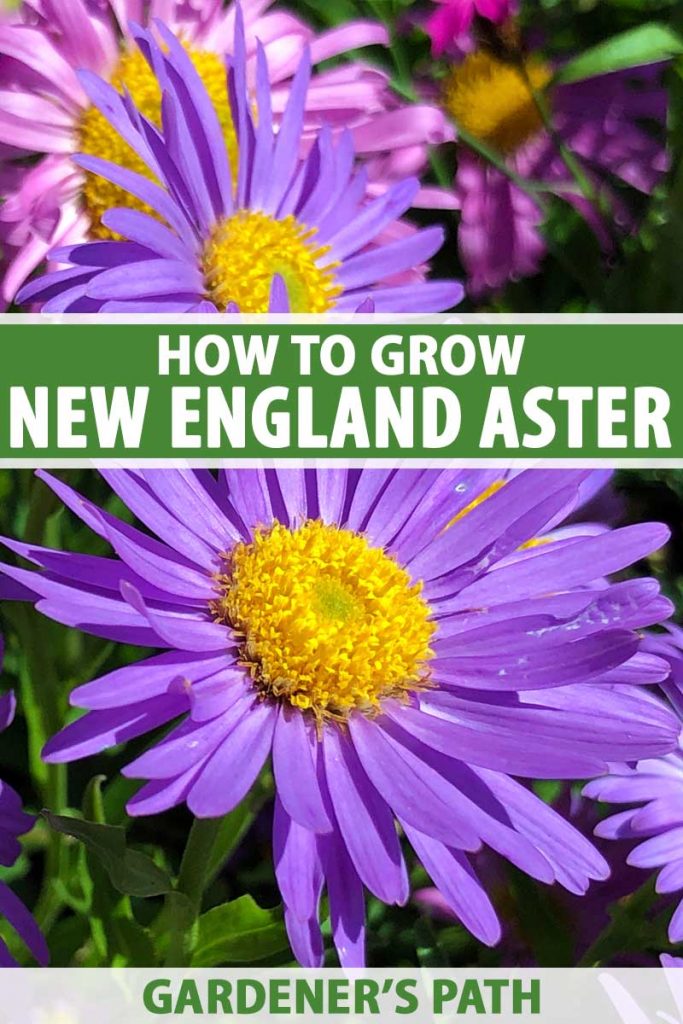

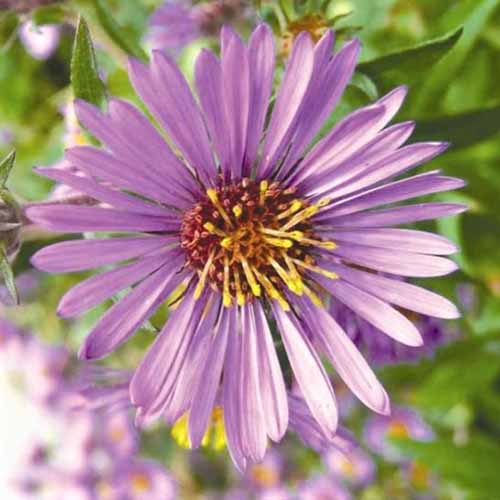

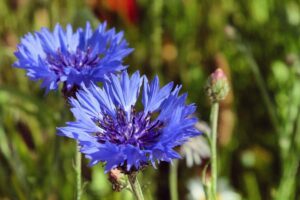

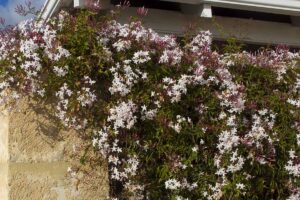
Awesome Nancy!
Thanks for reading, LuAnn!
Deer and groundhogs eat them. 🙁